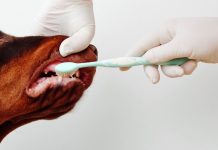Are cosmetic procedures, like ear cropping or debarking, something that pet guardians should consider?
A: The question of whether to put your dog through certain cosmetic procedures has fueled much debate. First, we will answer your question looking at both sides of this issue; at the end, we love to hear your opinion.
The three leading cosmetic procedures for dogs are ear cropping, tail docking, and debarking. These procedures are outlawed as animal abuse in some countries and debarking is illegal in some states in the US. While it is an individual decision as to whether or not you choose to take part in these procedures, it is essential that you consider the risks and implications. All of these procedures are elective, and do not have any medical correlation with an improved quality of life; therefore, it is essential that as a pet guardian, you make informed choices.
Tail Docking
Tail docking is a common procedure performed on a number of purebreeds, including Boxers, Rottweiler’s, Pit Bulls, and Doberman Pinchers. The preferred method most breeders use is called “banding”. This procedure involves tying off the tail for 1-4 days. Once the feeling is lost in the tail, it falls off. Because this procedure is done with no anesthesia, many breeders recommend that the puppy be no more than is 2-5 days of age. In a dog this age, the discomfort is minimal; however, as the dog ages, this process can be a painful one. Once a puppy is more than 5 days of age tail docking must be done under anesthesia.
Ear cropping
Ear cropping is a cosmetic procedure designed to create a pointed ear on a dog. Dogs undergo this surgery at 8-10 weeks of age. It is performed under anesthesia and involves the removal of a portion of the ear. Following surgery, the dogs’ ears must be bandaged for a few months, with bandages being changed every 2-3 days. It is recommended that pain medication be administered following surgery, as necessary. The healing process can be lengthy and painful for the dog, as their natural inclination is to scratch their ears to relieve the itching associated with this procedure. Additionally, no contact should be made with the ears during the healing process; therefore, it is recommended that dogs abstain from group play.
According to USA Today, the AKC believes that tail docking and ear cropping maintain the integrity of the breed. They assert that “as prescribed in certain breed standards, they are acceptable practices integral to defining and preserving breed character, enhancing good health and preventing injuries,” and that “any inference that these procedures are cosmetic and unnecessary is a severe mischaracterization that connotes a lack of respect and knowledge of history and the function of purebred dogs.” There have been a number of states that have attempted to ban these practices; however, the AKC has vehemently maintained their stance on the issue. As a result, breeders who choose to participate in AKC dog shows feel the pressure to conform to these requirements. Both breeders and pet owners alike often fail to consider the ramifications of these procedures. In some cases, tail docking and ear cropping can lead to infection, severe pain, disfigurement and amputation of the tail or ears. Some advocates claim that ear cropping prevents ear infections; however, there is no medical evidence to support that claim. As well, tail docking is said to prevent severe pain and damage to the tail later in life; however, this is still under debate.
Debarking
Debarking is a cosmetic procedure meant to silence the unwanted barking of a dog. Unlike tail docking and ear cropping, evidence of debarking is not always present. It is suspected that this procedure is common among pet owners who inhabit a residence within close proximity to their neighbors and for dogs used for show. A veterinarian performs this procedure under anesthesia, and the recovery time is minimal. The “annoying bark” is replaced by a barely audible, hoarse noise that emits from the dog.
Those in opposition of debarking feel that this procedure inhibits the ability for a pet to communicate their feelings of happiness, sadness, pain, and boredom. A common, and preferable, alternative for debarking is dog training. Any unwanted behavior found in a dog can be remedied through behavioral modification. By taking the time to work with your dog, both you and your pet develop a better understanding of one another. Your dog will understand the difference between appropriate and inappropriate behavior as well as your expectations while you learn the motivation behind his vocalization.
There are many different sides to this ethical debate. While some supporters feel that these procedures can prevent an animal’s demise, improve their quality of life, and make them more aesthetically pleasing, those in opposition feel that these procedures are painful, inhumane, and unnecessary. There is no proven research that any of these procedures contribute to the wellbeing of a dog. In fact, in certain cases, they can be painful and detrimental to a dog’s health.












